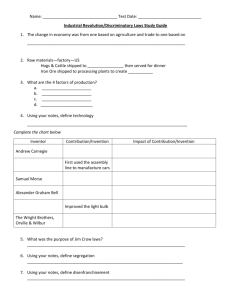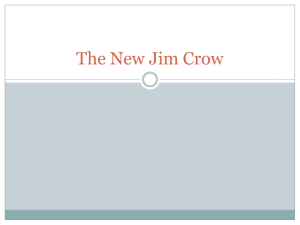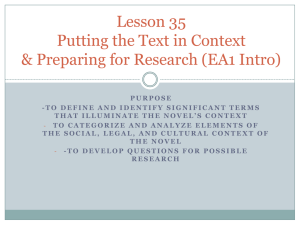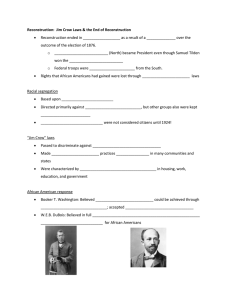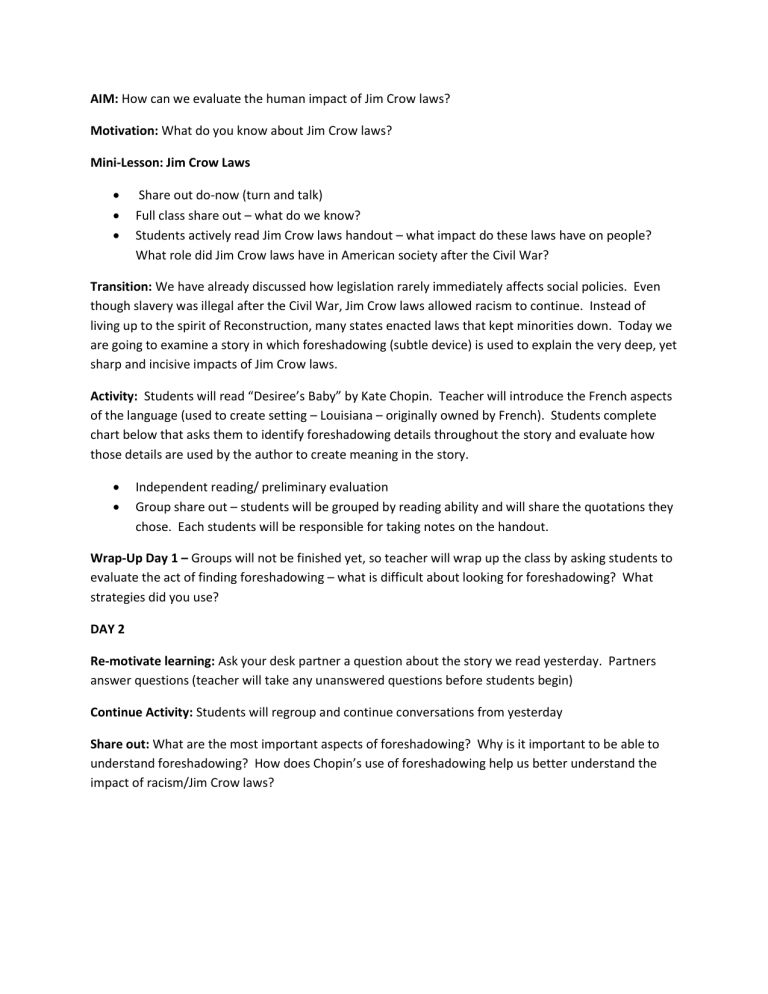
AIM: How can we evaluate the human impact of Jim Crow laws? Motivation: What do you know about Jim Crow laws? Mini-Lesson: Jim Crow Laws Share out do-now (turn and talk) Full class share out – what do we know? Students actively read Jim Crow laws handout – what impact do these laws have on people? What role did Jim Crow laws have in American society after the Civil War? Transition: We have already discussed how legislation rarely immediately affects social policies. Even though slavery was illegal after the Civil War, Jim Crow laws allowed racism to continue. Instead of living up to the spirit of Reconstruction, many states enacted laws that kept minorities down. Today we are going to examine a story in which foreshadowing (subtle device) is used to explain the very deep, yet sharp and incisive impacts of Jim Crow laws. Activity: Students will read “Desiree’s Baby” by Kate Chopin. Teacher will introduce the French aspects of the language (used to create setting – Louisiana – originally owned by French). Students complete chart below that asks them to identify foreshadowing details throughout the story and evaluate how those details are used by the author to create meaning in the story. Independent reading/ preliminary evaluation Group share out – students will be grouped by reading ability and will share the quotations they chose. Each students will be responsible for taking notes on the handout. Wrap-Up Day 1 – Groups will not be finished yet, so teacher will wrap up the class by asking students to evaluate the act of finding foreshadowing – what is difficult about looking for foreshadowing? What strategies did you use? DAY 2 Re-motivate learning: Ask your desk partner a question about the story we read yesterday. Partners answer questions (teacher will take any unanswered questions before students begin) Continue Activity: Students will regroup and continue conversations from yesterday Share out: What are the most important aspects of foreshadowing? Why is it important to be able to understand foreshadowing? How does Chopin’s use of foreshadowing help us better understand the impact of racism/Jim Crow laws? Quotation – choose a quote that represents the author’s use of foreshadowing. What is the author foreshadowing in this quotation? How does this example of foreshadowing impact the meaning of the story? “It shall be unlawful for a negro and white person to play together or in company with each other in any game of cards or dice, dominoes or checkers.” —Birmingham, Alabama, 1930 “It shall be unlawful for any white prisoner to be handcuffed or otherwise chained or tied to a negro prisoner.” —Arkansas, 1903 “No colored barber shall serve as a barber to white women or girls.” —Atlanta, Georgia, 1926 “Marriages are void when one party is a white person and the other is possessed of one-eighth or more negro, Japanese, or Chinese blood.” —Nebraska, 1911 “Any person...presenting for public acceptance or general information, arguments or suggestions in favor of social equality or of intermarriage between whites and negroes, shall be guilty of a misdemeanor and subject to a fine not exceeding five hundred dollars or imprisonment not exceeding six months or both fine and imprisonment in the discretion of the court.” —Mississippi, 1920 “Separate free schools shall be established for the education of children of African descent; and it shall be unlawful for any colored child to attend any white school, or any white child to attend a colored school.” —Missouri, 1929 “Any white woman who shall suffer or permit herself to be got with child by a negro or mulatto...shall be sentenced to the penitentiary for not less than eighteen months.” —Maryland, 1924 Jim Crow law information taken from the following source: "Jim Crow Laws - Separate Is Not Equal." Jim Crow Laws - Separate Is Not Equal. Smithsonian National Museum of American History, n.d. Web. 29 May 2013. <http://americanhistory.si.edu/brown/history/1-segregated/jim-crow.html>.

